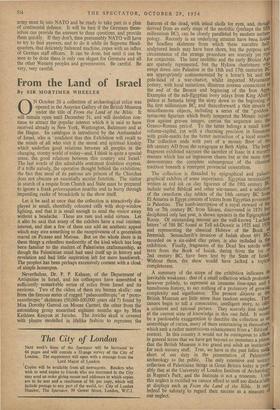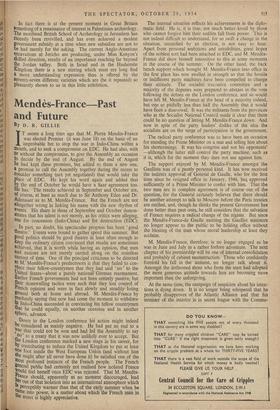From the Land of Israel
By SIR MORTIMER WHEELER ON October 26 a collection of archeological relics was opened in the Assyrian Gallery of the British Museum under the title of From the Land of the Bible. It will remain open until December 31, and will doubtless con- tinue to attract the popular interest which it is said to have received already in New York, Washington, Baltimore and at the Hague. Its catalogue is introduced by the Ambassador of Israel, who is ' confident that this Exhibition will recall to the minds of all who visit it the moral and spiritual kinship which underlies good relations between all peoples in the changing, stormy world of today—and, I think in quite a special sense, the good relations between this country and Israel.' The last words of this admirable sentiment doubtless express, if a trifle naïvely, the operative thought behind the exhibition; the fact that most of its patrons are princes of the Churches does not obscure an essentially secular function. The visitor in search of a respite from Church and State must be prepared to ignore a frank preoccupation israelite and to hurry through impending ranks of broadcloth to the show itself.
Let it be said at once that the collection is attractively dis- played in small, cheerfully coloured cells with shop-window lighting, and that it is small enough to send the visitor away without a headache. These are rare and solid virtues. Let it also be said that many of the exhibits have a real intrinsic interest, and that a few of them can add an aesthetic appeal which may owe something to the receptiveness of a generation reared on Picasso and Matisse. But on the whole there is in these things a relentless mediocrity of the kind which has long been familiar to the student of Palestinian craftsmanship, as though the Palestinian mind had used itself up in history and revelation and had little inspiration left for mere handiwork., The prophet has been perhaps excessively content with a cloak of simple homespun.
Nevertheless, Dr. P. P. Kahane, of the Department of Antiquities in Israel, and his colleagues have assembled a sufficiently remarkable series of relics from Israel and its environs. Two of the oldest of them are human skulls : one from the famous series of rugged 'palaeoanthropic ' or ' proto- neanthropic ' skeletons (50,000-100,000 years old ?) found by Miss Dorothy Garrod on Mount Carmel, the other from the astonishing group unearthed eighteen months ago by Miss Kathleen Kenyon at Jericho. The Jericho skull is- covered with plaster modelled in lifelike fashion to represent the features of the dead, with inlaid shells for eyes, and, though derived from an early stage of the neolithic (perhaps the fifth millennium BC), can be closely paralleled by modern anthro' pology. Recently in an underlying stratum have been found the headless skeletons from which these macabre half' sculptured heads may have been shorn, but the purpose and circumstance of the strange procedure are scarcely yet ripefor conjecture. The later neolithic and the early Bronze Age are sparsely represented, but the Hyksos charioteers who swept down into Palestine in the 18th and 17th centuries 13t-' are appropriately commemorated by a horse's bit and the pble-head of a war-chariot, whilst imported Mycenaean pottery, with local imitations, illustrate oversea connections at the end of the Bronze and beginning of the Iron Ages. Examples of the sub-Egyptian ivory inlays from King Ahab 's palace at Samaria bring the story down to the beginning of the first millennium BC, and thenceforward a thin stream of miscellaneous objects, including a series of the goddess terracotta figurines which freely tempered the Mosaic injutle' tion against graven images, carries the sequence into the Graeco-Roman period. To the latter belongs a small Ionic column-capital, cut with a charming precision in limestone with guide-marks for the better instruction of a local mason. The collection ends with part of a mosaic floor of the 6th century AD from the synagogue at Beth Alpha. The large fragment exhibited narrates the sacrifice of Isaac in a nursery manner which has an ingenuous charm but at the same time demonstrates the complete submergence of the classical tradition beneath a resurgent provincial orientalism.
The collection is threaded by epigraphical and palaco• graphical exhibits of some importance. Egyptian incantations written in red ink on clay figurines of the 19th century l3 include useful Biblical and other site-names, and a selection of the cuneiform clay tablets of the 14th century BC front El Amarna in Egypt consists of letters from Egyptian governors in Palestine. The tomb-inscription of a royal steward of cite 8th or 7th century BC from Siloam, discovered in 1870 but deciphered Only last year, is shown upstairs in the Epigraphical Room. Of outstanding interest are the well-known Lachish„ letters' of 586 BC found at Tell ed-Duweir in 1935 and 193o, and representing the classical Hebrew of the Book 9,1 Jeremiah. Sennacherib's invasion of Judah about 691 BC. recorded on a six-sided clay prism, is also included in the exhibition. Finally, fragments of the Dead Sea scrolls who texts from the Book of Isaiah, dating from the 1st or 2nd century BC, have been lent by the State of Israel; Without them, the show would have lacked a topical completeness. • A summary of the scope of the exhibition indicates its inevitable weakness : that of a small collection which professes• however politely, to represent an immense time-span and 0 tumultuous history, to say nothing of a prehistory of growin8 complexity and significance. The present disjecta at the British Museum are little more than random samples. TheY cannot begin to tell a consecutive, intelligent story, to offer, a coherent and rational picture. They scarcely hint indeed at the current state of knowledge in this vast field. It would be a pardonable exaggeration to describe the collection as an assemblage of curios, many of them entertaining in themselves: which seek a rather meretricious enhancement from a Biblical context. In this country it would not be outrageous to aflicol in general terms that we have got beyond so immature a phase, that the British Museum is too grand and adult an institution for such nursery stuff. True, we have in the past fallen sadli short of our duty in the presentation of Palestinian archaeology to the public, The only extensive and unitarY collection of Palestinian things in Great Britain today is prolr ably that at the University of London Institute of ArchmologY, in Regent's Park, and the Institute is not a museum. Until this neglect is rectified we cannot afford to sniff too disdainrullY at displays such as From the Land of the Bible. It may indeed be salutary to regard their success as a measure of our neglect. In fact there is at the present moment in Great Britain something of a renaissance of interest in Palestinian archaeology. The moribund British School of Archeology in Jerusalem has recently been revivified, and has even achieved a modest government subsidy at a time when new subsidies are not to e had merely for the asking. The current Anglo-American excavations at Jericho are producing, under Miss Kenyon's Skilled direction, results of an importance reaching far beyond the Jordan valley. Both in Israel and in the Hashemite Kingdom there is a new stirring which must ere long find a more understanding expression than is offereci by the Seventy-seven different varieties which are (be it repeated) so pleasantly shown to us in this little exhibition.



































 Previous page
Previous page